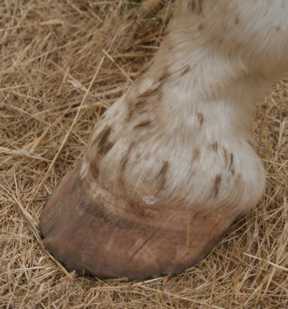 |
HealthyHoof.comHoofcare & Information for Barefoot SoundnessLinda Cowles Hoof Care - Serving the greater SF Bay Area and Northern California |
Cherokee's ConcavitySept 2008 - The Power of the Bevel & the Mustang Roll |
|
|
|
7/2006 This case study illustrates how flat wall edge results in lack of concavity and thin soles. One of the most common reasons people feel their horse isn't a candidate for barefoot is that the horse has "flat feet" or "weak walls". Cherokee has been sound and barefoot for years, even though he had flat, leathery soles and brittle walls the first time I trimmed him. One month after applying a beveled edge to his walls, Cherokee's concavity had improved dramatically. Cherokee lives on a 40 acre pasture in the dairy pasture lands of Western Sonoma County, just 5 miles from where the popular California Happy Cow commercials are filmed. The soil is a mix of sand and has minimal rock. The annual grasses are lush in the spring and late winter, and golden brown by early June. |
|
|
The top hoof picture shows the long wall on the left has flared out. As a horse weights a foot, the bony column presses downward, pushing the sole against the ground. If the sole contacts the ground, it begins wearing. When a hoof's wall grows long enough to bend, the lower edge flares to the outside, and the curve of the bow presses inward, increasing the downward pressure in the inner hoof. |
|
About Cherokee... Twenty year old Cherokee is Lucas's pasture mate, and has been barefoot for a long time. Katja, Lucas's owner, has been encouraging Cherokees owner to use me to trim Cherokee because his soles were so flat and his walls flared. Tanya was hesitant to try another farrier because Cherokee is terrified of having his feet handled and pulls violently without warning. When she asked how I would deal with this, I replied that I'm patient but firm, and it would depend on what triggered the episode, but that I was very willing to try working with him. If he was too time consuming, I'd charge an hourly rate to cover the training. Tanya was still skeptical that we could work together, but agreed to try. Tanya was right about Cherokee's reactiveness! He's a hard horse to work on, so there aren't any finishing touches on these feet, and the photos aren't great, but they are adequate to illustrate the point. |
||
| July 1st, 2006 | ||
Cherokee has thick walls, a durable frog, a very dense digital cushion and thick lateral cartilages. His feet had been trimmed 8 weeks before, and the walls edges were starting to crack and chip. The wall had flared at the edges, resulting in white line separation. Cherokee was sound on the pasture but walked carefully on the graveled drive. His sole was thin, but not remarkably so. He used his heel, but the marks on the sole indicate that his landing is slightly more toe-first. |
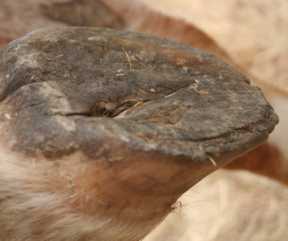 |
|
|
||
August 2, 2006 |
||
In one short month, Cherokees foot developed a good start on concavity. He has started shedding sole, and his heels are being used better. His whit line separation is still a problem, so the trim plan is to remove flare and bevel more aggressively. |
||
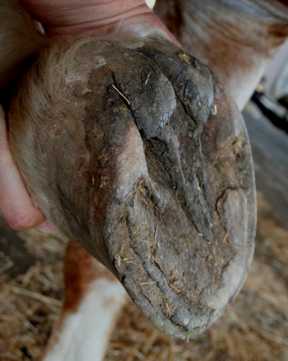 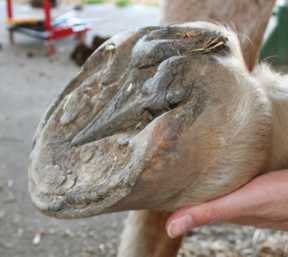 |
||
Below, post trim shots from August 2. Note from 9/2008 - The picture on the right looks like the toe is carrying more that its fair share of the landing force; the frog was shedding and there may have been a little thrush under it. |
||
Serving the greater SF Bay Area & Northern California
Home | Contact Linda | Privacy | About Us
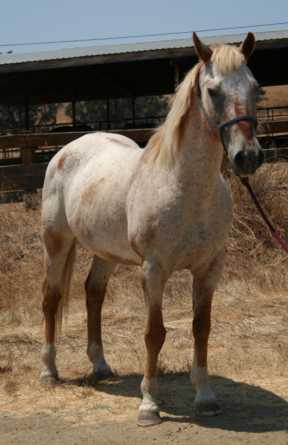
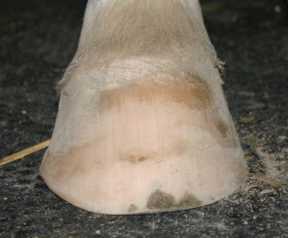
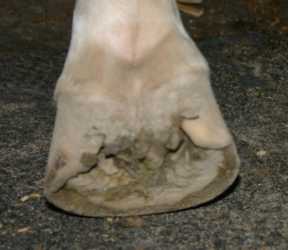
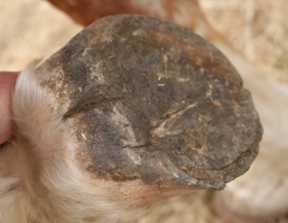 ...
...